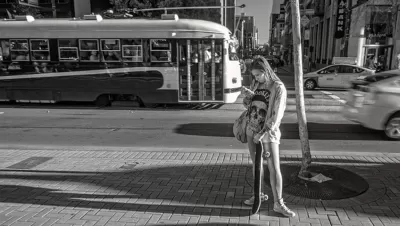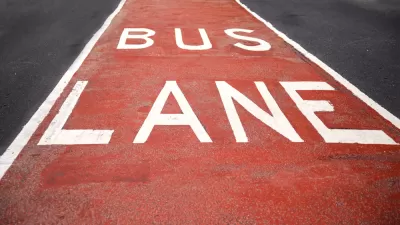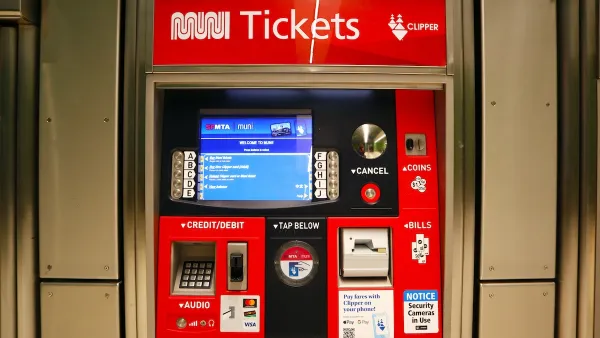One idea for how to make transit better is rolling out in cities across the country: mobile payment of fares on smartphones.

On November 16, the San Francisco Municipal Transportation Agency (SFMTA) officially launched MuniMobile, a new mobile ticketing app developed in partnership with GlobeSherpa, a subsidiary of the transportation technology company RideScout. The app allows users to purchase, store, and use single or multiple Muni fares on their smartphones. While this is the first transit payment app in the San Francisco Bay Area, consumer adoption of transit mobile ticketing is growing at a strong pace across the country. Mobile transit payments have been launched or will launch in 13 cities within the next year, including in the major metropolitan areas of San Francisco, Chicago, Atlanta, Los Angeles, and Washington, D.C.
The case for mobile transit payments
 Ubiquitous access to mobile phones is already changing the way people move in cities. The rise of on-demand mobility services such as Uber and Lyft has been spurred by the widespread adoption of GPS-enabled smartphones, which—according to the Pew Research Center [1, 2]—are now owned by the majority of Americans.
Ubiquitous access to mobile phones is already changing the way people move in cities. The rise of on-demand mobility services such as Uber and Lyft has been spurred by the widespread adoption of GPS-enabled smartphones, which—according to the Pew Research Center [1, 2]—are now owned by the majority of Americans.
It is clear that customers want more convenient ways to pay for transportation services. Apart from being faster and more flexible than paper tickets, mobile transit payments reduce many of the stresses associated with transit use, including potentially missing the bus while loading cash onto a fare card or not having exact change. Interestingly, a recent global survey showed that a majority of public transit users were willing to pay more if they could use a smartphone to pay for their journey [3]. The adoption of mobile payment by transit is critical for their survival in an increasingly competitive market for transportation services.
Here are three ways that the transition to mobile transit payments will change the way we move in cities.
1. Ease of payment attracts new customers
 Transit ridership has started to increase in the United States. Historically, however, the numbers have been dismally low. The percentage of workers who usually travel to work by public transportation has remained at about 5 percent since the 1990 Census [4]. In this context, ease of transit payment will undoubtedly attract new customers, and shifting more people to mass transit could lead to fewer cars on the road.
Transit ridership has started to increase in the United States. Historically, however, the numbers have been dismally low. The percentage of workers who usually travel to work by public transportation has remained at about 5 percent since the 1990 Census [4]. In this context, ease of transit payment will undoubtedly attract new customers, and shifting more people to mass transit could lead to fewer cars on the road.
One of the reasons that on-demand services such as Uber and Lyft have been so popular among consumers is mobile payment. According to a 2014 study by UC Berkeley, "ease of payment" was the top cited reason that respondents chose on-demand mobility services such as Uber and Lyft over other alternatives [5]. By enabling mobile transactions, transit services can also attract a larger segment of customers—providing more people with options to get around in cities.
2. Cashless payments improve the efficiency of transit
Not only are mobile payments easier for consumers to use, they also improve the efficiency of transit operations. Passengers with cashless payments board buses and trains more quickly than those fiddling to find and pay exact change [6]. The efficiencies gained from mobile ticketing improves the transit experience for everyone.
On buses, contactless payment and proof-of-payment systems also allow passengers to board through all vehicle doors. An SFMTA study found that all-door boarding reduced the dwell time (time spent in once place) of Muni buses by 38 percent, making service more reliable and predictable [7].
3. Big data enables smarter transportation
 Analysis of data gathered through mobile transit payments allows agencies to make better strategic, tactical and real-time decisions. Big data—suitably anonymized traces of ticket purchase and usage—generated by these systems can help transit agencies with strategic long-term network planning; tactical schedule adjustments; the provision of real-time information to users, and potentially, the ability to push out real-time incentives to balance peak demand.
Analysis of data gathered through mobile transit payments allows agencies to make better strategic, tactical and real-time decisions. Big data—suitably anonymized traces of ticket purchase and usage—generated by these systems can help transit agencies with strategic long-term network planning; tactical schedule adjustments; the provision of real-time information to users, and potentially, the ability to push out real-time incentives to balance peak demand.
While the adoption of smart cards (e.g., Clipper in the Bay Area) in regions across the world has long enabled transit agencies to collect more data to better understand their systems, it’s a little known fact that these systems generally do not provide real-time information to the transit agency or the transit user. Fare collection data from smart cards is typically uploaded and downloaded when buses and trains reach garages. The transition to mobile transit payments presents significant opportunities to harness data for smarter, real-time, demand responsive transportation.
Mobile payments are the next logical step for transit agencies—the ability to book, pay, and obtain real-time information about transit services will attract a new generation of users – improving the transit experience, reducing emissions, and changing the way we move in cities.
Regina Clewlow, Ph.D. is the Director of Transportation Research and Policy of RideScout, a transportation technology company bringing seamless mobility to cities around the world. Dr. Clewlow is also a research scholar on future mobility at Stanford University and the U.C. Davis Institute of Transportation Studies.
[1] Pew Research Center. (2014). Cell Phone and Smartphone Ownership Demographics. Retrieved from http://www.pewinternet.org/data-trend/mobile/cell-phone-and-smartphone-ownership-demographics/
[2] Pew Research Center (2015). U.S. Smartphone Use in 2015. Retrieved from http://www.pewinternet.org/2015/04/01/us-smartphone-use-in-2015/
[3] Accenture (2013). What travelers want from public transport providers. Retrieved from https://www.accenture.com/us-en/insight-acn-public-transport-survey.aspx
[4] U.S. Census Bureau. (2010). Public Transportation Usage Among U.S. Workers: 2008 and 2009. Retrieved https://www.census.gov/prod/2010pubs/acsbr09-5.pdf
[5] Rayle, L. et al. (2014). App-Based, On-Demand Ride Services: Comparing Taxi and Ridesourcing Trips and User Characteristics in San Francisco University of California Transportation Center (UCTC). UCTC-FR-2014-08.
[6] White et al. (2010). The role of smartcard data in public transport. In12th World Conference on Transport Research, Lisbon, Paper(No. 1461).
[7] San Francisco Municipal Transportation Authority (SFMTA). (2014). All-Door Boarding Evaluation Final Report. Retrieved from https://www.sfmta.com/sites/default/files/agendaitems/2014/12-2-14%20Item%2014%20All%20Door%20Boarding%20Report.pdf

Maui's Vacation Rental Debate Turns Ugly
Verbal attacks, misinformation campaigns and fistfights plague a high-stakes debate to convert thousands of vacation rentals into long-term housing.

Planetizen Federal Action Tracker
A weekly monitor of how Trump’s orders and actions are impacting planners and planning in America.

San Francisco Suspends Traffic Calming Amidst Record Deaths
Citing “a challenging fiscal landscape,” the city will cease the program on the heels of 42 traffic deaths, including 24 pedestrians.

Defunct Pittsburgh Power Plant to Become Residential Tower
A decommissioned steam heat plant will be redeveloped into almost 100 affordable housing units.

Trump Prompts Restructuring of Transportation Research Board in “Unprecedented Overreach”
The TRB has eliminated more than half of its committees including those focused on climate, equity, and cities.

Amtrak Rolls Out New Orleans to Alabama “Mardi Gras” Train
The new service will operate morning and evening departures between Mobile and New Orleans.
Urban Design for Planners 1: Software Tools
This six-course series explores essential urban design concepts using open source software and equips planners with the tools they need to participate fully in the urban design process.
Planning for Universal Design
Learn the tools for implementing Universal Design in planning regulations.
Heyer Gruel & Associates PA
JM Goldson LLC
Custer County Colorado
City of Camden Redevelopment Agency
City of Astoria
Transportation Research & Education Center (TREC) at Portland State University
Jefferson Parish Government
Camden Redevelopment Agency
City of Claremont




























